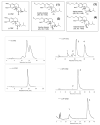Characterization of optically resolved 9-fluoropropyl-dihydrotetrabenazine as a potential PET imaging agent targeting vesicular monoamine transporters
- PMID: 17383573
- PMCID: PMC1919419
- DOI: 10.1016/j.nucmedbio.2006.12.005
Characterization of optically resolved 9-fluoropropyl-dihydrotetrabenazine as a potential PET imaging agent targeting vesicular monoamine transporters
Abstract
Labeling derivatives of dihydrotetrabenazine (DTBZ) with F-18 (T(1/2)=110 min) instead of C-11 (T(1/2)=20 min) would improve their utility and availability for imaging vesicular monoamine transporters (VMAT2) in clinical settings. The successful synthesis, reported previously, of two novel 9-fluoroalkyl(+/-)-DTBZ ligands prompted us to study the optically resolved active ligand 9-fluoropropyl-(+)-DTBZ (FP-(+)-DTBZ), which may have more promising characteristics. The inhibition constant (K(i)) estimated for FP-(+)-DTBZ (using [(3)H](+/-)-DTBZ as the labeled ligand in rat striatal homogenates) showed a lower value as compared to the racemic FP-(+/-)-DTBZ (0.10+/-0.01 vs 0.19+/-0.04 nM). The inactive isomer, FP-(-)-DTBZ, displayed a much lower binding affinity with a K(i) value >3000 nM. Biodistribution studies in mice after an iv injection of [(18)F]FP-(+)-DTBZ exhibited a ratio of striatum (ST, target) to cerebellum (CB, background) of 4.51 at 30 min postinjection, which is a higher value than previously obtained with the racemic ligand [(18)F]FP-(+/-)-DTBZ (ST/CB=2.95). Brain extraction at 30 min after the tracer injection in mice showed that >95% of the radioactivity corresponded to the parent, nonmetabolized, compound remaining in the ST, suggesting that the tracer has an excellent in vivo stability. Furthermore, localization of the tracer in the brain examined with ex vivo autoradiography displayed a typical distribution pattern consistent with VMAT2 sites. The highest labeling was observed in monoaminergic neuron regions (caudate putamen, olfactory tubercle, nucleus accumbens, substantia nigra, dorsal raphe and locus coerules). We also tested the selective labeling of this tracer at the dopamine neurons in unilateral-lesioned mice (treated with 6-hydroxydopamine). When [(18)F]FP-(+)-DTBZ and [(125)I]IPT ((N-(3'-iodopropen-2'-yl)-2-beta-carbomethoxy-3-beta-(4-chlorophenyl)tropane, a selective marker for dopamine transporters (DATs) in dopaminergic neurons) were simultaneously injected into lesioned mice, we observed an excellent correlation (r=0.95) for these tracers. From these findings, we conclude that [(18)F]FP-(+)-DTBZ is a sensitive and selective tracer for VMAT2 binding sites and it may be useful for in vivo evaluation of diseases relating to changes of monoamine neuronal integrity.
Figures




Similar articles
-
Fluoroalkyl derivatives of dihydrotetrabenazine as positron emission tomography imaging agents targeting vesicular monoamine transporters.Nucl Med Biol. 2006 Aug;33(6):685-94. doi: 10.1016/j.nucmedbio.2006.05.006. Nucl Med Biol. 2006. PMID: 16934687
-
Deuterated 18F-9-O-hexadeutero-3-fluoropropoxyl-(+)-dihydrotetrabenazine (D6-FP-(+)-DTBZ): A vesicular monoamine transporter 2 (VMAT2) imaging agent.Nucl Med Biol. 2018 Feb;57:42-49. doi: 10.1016/j.nucmedbio.2017.11.009. Epub 2017 Dec 6. Nucl Med Biol. 2018. PMID: 29306111
-
Pharmacokinetics of [(18)F]fluoroalkyl derivatives of dihydrotetrabenazine in rat and monkey brain.Nucl Med Biol. 2007 Apr;34(3):233-7. doi: 10.1016/j.nucmedbio.2007.01.007. Nucl Med Biol. 2007. PMID: 17383572 Free PMC article.
-
(+)-2-Hydroxy-3-isobutyl-9-(3-[18F]fluoropropoxy)-10-methoxy-1,2,3,4,6,7-hexahydro-11bH-benzo[a]quinolizine.2007 Feb 12 [updated 2010 Oct 14]. In: Molecular Imaging and Contrast Agent Database (MICAD) [Internet]. Bethesda (MD): National Center for Biotechnology Information (US); 2004–2013. 2007 Feb 12 [updated 2010 Oct 14]. In: Molecular Imaging and Contrast Agent Database (MICAD) [Internet]. Bethesda (MD): National Center for Biotechnology Information (US); 2004–2013. PMID: 20641662 Free Books & Documents. Review.
-
Classics in Neuroimaging: Radioligands for the Vesicular Monoamine Transporter 2.ACS Chem Neurosci. 2019 Jan 16;10(1):25-29. doi: 10.1021/acschemneuro.8b00429. Epub 2018 Sep 10. ACS Chem Neurosci. 2019. PMID: 30198706 Review.
Cited by
-
Radiopharmaceuticals for positron emission tomography investigations of Alzheimer's disease.Eur J Nucl Med Mol Imaging. 2010 Aug;37(8):1575-93. doi: 10.1007/s00259-009-1301-z. Epub 2009 Dec 22. Eur J Nucl Med Mol Imaging. 2010. PMID: 20033156 Review.
-
Cross-sectional and Test-Retest Characterization of PET with [(18)F]FP-(+)-DTBZ for β Cell Mass Estimates in Diabetes.Mol Imaging Biol. 2016 Apr;18(2):292-301. doi: 10.1007/s11307-015-0888-7. Epub 2015 Sep 14. Mol Imaging Biol. 2016. PMID: 26370678 Free PMC article. Clinical Trial.
-
A Purification Method of 18F-FP-(+)-DTBZ via Solid-Phase Extraction With Combined Cartridges.Front Med (Lausanne). 2021 Jul 9;8:693632. doi: 10.3389/fmed.2021.693632. eCollection 2021. Front Med (Lausanne). 2021. PMID: 34307421 Free PMC article.
-
In vivo studies of the SERT-selective [18F]FPBM and VMAT2-selective [18F]AV-133 radiotracers in a rat model of Parkinson's disease.Nucl Med Biol. 2010 May;37(4):479-86. doi: 10.1016/j.nucmedbio.2010.01.006. Nucl Med Biol. 2010. PMID: 20447560 Free PMC article.
-
PET imaging a MPTP-induced mouse model of Parkinson's disease using the fluoropropyl-dihydrotetrabenazine analog [18F]-DTBZ (AV-133).PLoS One. 2012;7(6):e39041. doi: 10.1371/journal.pone.0039041. Epub 2012 Jun 18. PLoS One. 2012. PMID: 22723923 Free PMC article.
References
-
- Albin R, Koeppe R. Rapid loss of striatal VMAT2 binding associated with onset of Lewy body dementia. Mov Disord. 2006;21:287–88. - PubMed
-
- Kilbourn MR. In vivo radiotracers for vesicular neurotransmitter transporters. Nucl Med Biol. 1997;24:615–9. - PubMed
-
- Stoessl AJ, de la Fuente-Fernandez R. Dopamine receptors in Parkinson's disease: imaging studies. Adv Neurol. 2003;91:65–71. - PubMed
-
- Tatsch K. Can SPET imaging of dopamine uptake sites replace PET imaging in Parkinson's disease? For Eur J Nucl Med Mol Imaging. 2002;29:711–14. - PubMed
-
- Frey KA. Can SPET imaging of dopamine uptake sites replace PET imaging in Parkinson's disease? Against Eur J Nucl Med Mol Imaging. 2002;29:715–17. - PubMed
Publication types
MeSH terms
Substances
Grants and funding
LinkOut - more resources
Full Text Sources
Other Literature Sources
Medical

